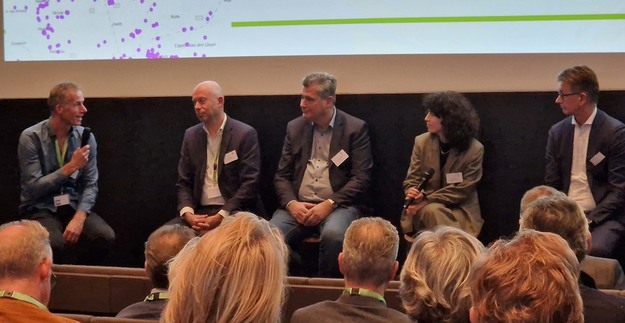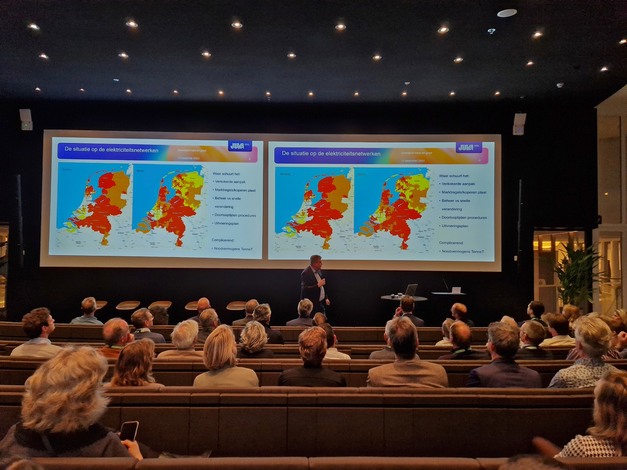Is getting horticulture off the gas as quickly as possible necessarily the best thing for the Netherlands? That tantalizing question was posed by tomato grower Paul van Schie during Greenport West-Holland's Meet & Greet Energy.
His ardent contribution, along with that of Atoesa Farokhi, who had the noble task of representing 'society,' stood out the most during the meeting, which also featured such familiar cries as "accelerate energy transition," "climate neutral in 2040" and "important economic sector."
As Coordinator of External Cooperation at Amsterdam Green Campus, Atoesa dared to place critical notes on all that was discussed. For example, it struck her that it seems as if greenhouse horticulture companies are more energy suppliers these days than primary producers of healthy food. Isn't that odd?
Playing energy supplier is not an end in itself
Grower Paul was willing to explain how this came about, and Jacco Besuijen, who was in the audience on behalf of tomato grower Schenkeveld, also made a point. According to the latter, it has never been the goal of growers to become energy suppliers. The goal is still to grow products that are as healthy as possible. "For that, we only need a little hot water," he says.
More and more growers, like Paul, are getting some of that hot water from geothermal heat sources. That's sustainable but sometimes expensive. And that, in turn, is difficult in a highly competitive market where there is always pressure on cost. So, when growers saw an opportunity to reduce their cost price by purchasing a cogeneration plant, they did so.
There will come a time when the spark spread (1) gets worse. Paul knows that, and that's what Rien Bot of AgroEnergy, the afternoon's host, pointed out. In that case, Paul predicts, horticulture will naturally move with the market again. Rien: "The strength of horticulture has always been responding well to short-term developments."

Panel discussion with from left to right Paul van Schie, Sander Mertens, Frank Binnekamp, Atoesa Farokhi, and Rien Bot
Not getting off the gas too fast
Before the discussion between the various speakers and the audience erupted, seven speakers and chairman of the day, Martin van der Hout of organizer Greenport West-Holland, had all briefly told their stories. Short, because seven speakers in an hour is a lot. It worked wonderfully well because the speakers did not go into too much depth but rather briefly touched on topics for discussion and reflection.
Meindert Stolk, Chairman of Greenport West-Holland and Member of the Provincial Executive of the Province of South Holland kicked off in front of an audience of about fifty people. Predominantly policymakers and officials, but also a handful of growers and other energy interested people.
After Meindert, Frank van Kuppeveld, Ambassador of the Energy Agreement of Greenport West-Holland and alderman in the municipality of Pijnacker-Nootdorp, was given the floor. He emphasized, just as Meindert had done in other words, that shifting from gas must be done in such a way that the horticulture itself still experiences it.

Peaks are a problem
Things then went a little deeper in the presentation by Frank Binnekamp, CEO of electricity company Juva. Standing in front of a traffic jam map that is turning red all the time, he talked about grid congestion and how to solve it.
Making the grid heavier is one solution, but not the only one. Westland, for example, has hardly any congestion, but the large availability of emergency capacity for growers with CHP plants still causes peaks in the grid, so the grid sometimes still threatens to become 'full.'
The challenge is to make the best possible use of the available capacity. Integral grid management is what Juva is working on and working together. For example, in the construction of charging station infrastructure. Not every man for himself, but jointly, making it easier to balance peaks and troughs in the entire system.
Sander Mertens, Professor of Energy in Transition at The Hague University of Applied Sciences and director of the Centre of Expertise Mission Zero, advocated risk mitigation in a story about the energy system of the future. Precisely solving the peaks, about 100 days a year in the case, is expensive. Only by looking at adjustments in storage and supply together with time management and strengthening the grid can the problem really be solved, according to Sander.
Peaks are expensive
Rien Bot's talk revolved around the decarbonization of the energy mix. There was an explanation of the merit order, in which energy sources are ranked according to price or degree of pollution.
The energy transition will cause things to shift in the merit order. There will be more wind and solar energy, but the consequence will be that a lower volume of gas-generated electricity will mean that when it is really needed, electricity generated from gas will be a lot more expensive than now.
Paul van Schie of the tomato growing company Fa. L.A. van Schie then introduced the audience to his tomato-growing company and especially his geothermal heat project, Nature's Heat. In his talk, he pointed out how he sees challenges in making the last approximately 20 percent of his heat demand more sustainable.
Growers defend Dutch tomato
Atoesa Farokhi of Amsterdam Green Campus pulled the audience back from the energy and greenhouse jargon for a moment. She challenged those present to explain the horticulture and energy transition. In doing so, she set the stage for the panel discussion mentioned briefly above.
In that panel discussion, Paul, in particular, defended the sector with the arguments those of us within the sector are now familiar with. Outside the sector, many of those facts are not known. "What value is really behind this role of greenhouse horticulture companies as energy suppliers," Atoesa therefore wanted to know.
Paul and Jacco responded by pointing out how progressive Dutch horticulture is. There was also a brief discussion about what is really better: tomatoes from the Netherlands or imported tomatoes from abroad if growing them here is impossible. What the growers think about this is clear.
The price of heat
But it has to remain possible. "If the heat from geothermal heat costs 50 euro cents per cubic meter in some projects, then I do worry," Paul let slip. As far as he is concerned, 30 euro cents is the limit. Waste heat from the Rotterdam harbor, which is being discussed, should not cost more than 20 euro cents if it is up to the growers.
Whether those prices will be realistic in the future remains to be seen. From the audience, a man from the Port of Rotterdam Authority announced that there are plans for a pilot in which heat from geothermal energy and the port are combined in heat networks. Who knows, maybe more will be known about this next year during a new Meet & Greet Energy.
(1) Spark spread is the difference between the yield of electricity on the wholesale market and the cost of the raw materials used to produce that electricity.
